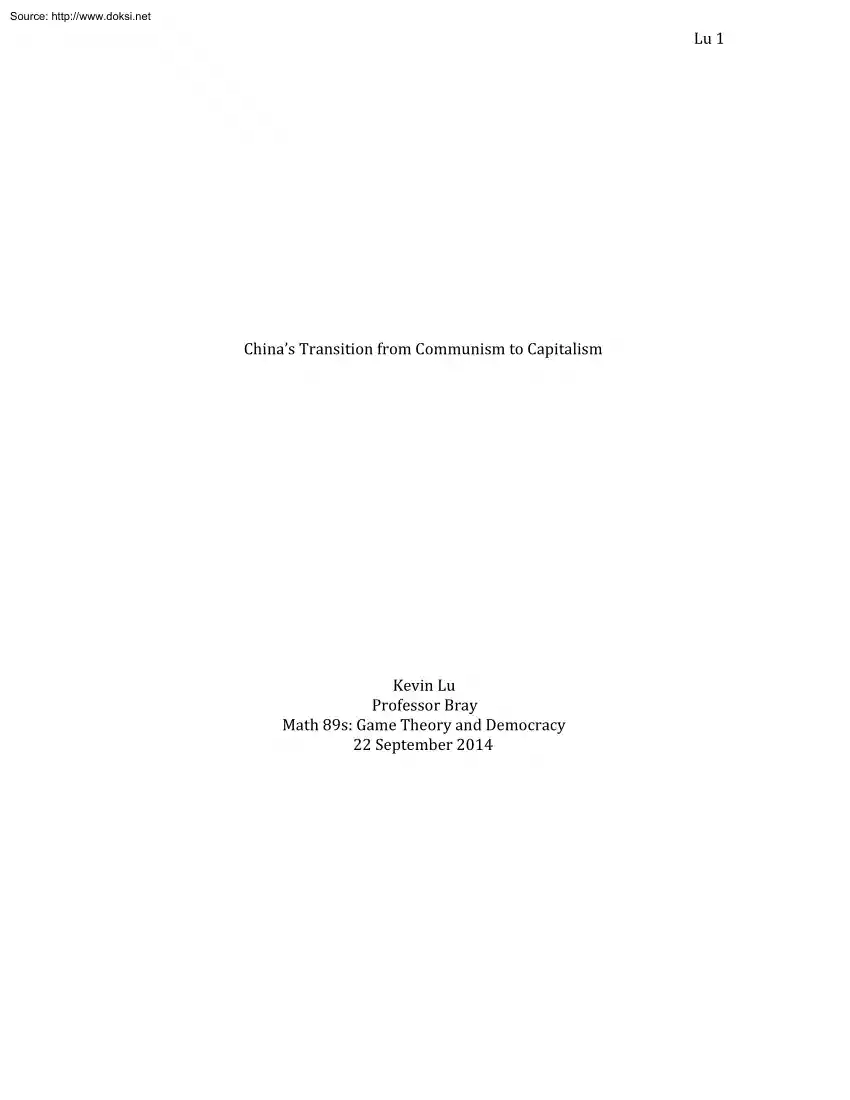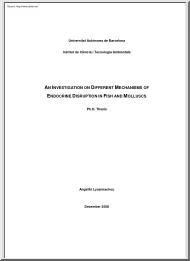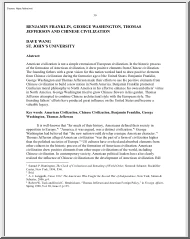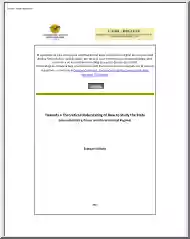Értékelések
Nincs még értékelés. Legyél Te az első!
Mit olvastak a többiek, ha ezzel végeztek?
Tartalmi kivonat
Source: http://www.doksinet Lu 1 China’s Transition from Communism to Capitalism Kevin Lu Professor Bray Math 89s: Game Theory and Democracy 22 September 2014 Source: http://www.doksinet Lu 2 I: Introduction China has been a major human civilization since the dawn of mankind. A land with a vast history and rich culture, China boasts unrivaled contributions to human advancement that few other societies can match. Expanding across most of Eastern Asia, China naturally encompasses a large and diverse population, resulting in an array of different dialects and ethnicities just within a single nation. Relatively recently, China has gradually shifted its economic structure from strict Communism to a system resembling that of a more free-market system. But in order to fully understand the transition, it’s important to have a little background on China itself. II: History and Background China began thousands of years ago as a cradle of civilization in the Yellow River Valley. The
earliest signs of man date back to 10,000 BCE, back when hunting and gathering were still the primary methods of survival. However, it wasn’t until approximately 2100 BCE that China’s first dynasty, the Xia Dynasty, became established. By then, farming was well under way, along with early technologies such as pottery and bronze smelting. After the fall of the Xia Dynasty, the Shang Dynasty came into power, and with it came the first written records of Chinese civilization. The earliest cities also developed during this era, as surpluses from farming allowed people to focus on specializing in other trades. Following the Shang Dynasty was a chain of powerful dynasties, which at times Source: http://www.doksinet Lu 3 was interrupted by long periods of fighting amongst smaller warring kingdoms vying for power over others. With each succession in the chain of dynasties, more and more advanced technologies and culture developed, while land conquests pushed the borders further
outwards. Several thousand years later, the final Chinese Dynasty, called the Qing Dynasty, collapsed in 1911 due to internal stagnant leaders and external intervention from Europe and America (McDowell). What followed were decades of turmoil and conflict between the two major powers within China: the Nationalist Party, headed by Sun Yat-sen and later Chiang Kai-shek, and the Communist Party, most notably led by Mao Zedong. During World War II, the two parties formed a nominal alliance against the invading Japanese, but the Nationalist Party received the heaviest casualties from the war, allowing the Communist Party to force oust the Nationalists and take control of the nation. Thus begins the era of unopposed Communism in China, one that has lasted to this day, as China remains the last major stronghold of Communism in the world (Communist Party). III: Mao’s Reign After Mao took power, he began to shape China utilizing a variety of strategies and methods. One key development that
the new People’s Republic of China implemented was a series of initiatives called Five-year plans, which were designed to boost China’s industrialization and promote economic and social growth. Although these plans did help to modernize China, they sometimes only Source: http://www.doksinet Lu 4 saw limited success, and generally came at a high cost (China). One of the costliest socio-economic campaigns, known as the Great Leap Forward, was intended to turn China from an agrarian-based society to an industrialized society via agricultural collectivization. Instead, it triggered a famine that resulted in as many as 45 million deaths. Several years after the expensive catastrophe, Mao launched yet another socio-political movement known as the Cultural Revolution, this time focusing on a return to “true Communism” and a purging of any capitalist ideals. Again, Mao’s movement accomplished nothing more than to cripple China’s progress both socially and economically, yet the
Cultural Revolution continued until Mao’s death in 1976 (Cultural Revolution). IV: China’s Economic Transition Although the man who effectively succeeded Mao never officially held the highest office, Deng Xiaoping would come to be the de facto paramount leader and oversee the beginning of China’s transition from Communism to Capitalism. Starting in 1976 at the death of Mao Zedong, Deng Xiaoping teamed up with Mao’s designated successor Hua Guofeng to launch the first wave of state-led, investment driven program focusing on heavy industry in order to jumpstart China’s economic modernization. However, the program terminated early due to internal weaknesses and changes in leadership. Nevertheless, Deng bounced back with a new strategy, which led to the second wave of government reform under the designs of another high level official Chen Yun. Chen’s strategy directly Source: http://www.doksinet Lu 5 contradicted Hua’s earlier ideas of focusing on heavy industries--Chen
preferred to balance out the economy with more investments into light industries and agriculture, while at the same time allowing more fiscal autonomy to provincial governments to decentralize the economy. This new direction resulted in an increase of consumer goods production rather than capital goods production, as well as a surge in the agriculture sector. Furthermore, during this time Beijing began to loosen their restrictions on state-owned enterprises and let them keep some of their own profits in order to incentivize additional enterprises. All of these government reforms without a doubt played crucial roles in helping to initiate China’s transition to capitalism; however, in hindsight, some the biggest contributors to China’s economic progression can actually be traced to parallel grassroot movements not instituted by the government (Coase). During this period of economic transformation, several rising factors independent of the government paved the way to the China of
today. First and foremost was the privatization of farming, or rather, the re-privatization of farming. Before Mao had relentlessly collectivized farming, private farming had existed for thousands of years. And after disasters like the famines of the Great Leap Forward, there was no more denying that collectivization of farming just didn’t work. At first Beijing would only allow private farming in specifically controlled regions, but privatization quickly spread until it was made a national policy in 1982. Another marginal factor to China’s transformation were township and village enterprises. These rural industrial operations, which did not benefit Source: http://www.doksinet Lu 6 from the secured channels of raw materials and markets that state enterprises enjoyed, were unrestricted by the government and quickly found ways around the regulations that allowed them to outperform their state-run counterparts. Finally, Special Economic Zones were permitted to be established in
tightly controlled regions. These Zones were designated areas to experiment with market economies using foreign techniques and strategies. However, they were strictly confined to avoid potentially undermining socialism, which stunted possible growth. Each of these individual factors helped China make marginal advances towards capitalism, and with all of them working together over the course of several decades, coupled with the Chinese government’s efforts in the state sector, China has been able to turn its economy around from a broken and debilitated state in the seventies to a leading worldwide powerhouse in the twenty first century (Coase). V: China Today and the Environment In today’s world, with regards to the environment, modern China is almost in a Prisoner’s Dilemma with the rest of the world. Currently, with global warming increasing at an unprecedented rate, many Western countries are starting to look for alternative solutions to the burning of fossil fuels, especially
renewable resources such as wind and solar energy. On the other hand, China’s main priority has been to try and catch up with the western countries, which is why China has been taking industrialization and production to unprecedented Source: http://www.doksinet Lu 7 levels. This has come at a cost, most obviously a cost to the environment, since China needs energy to power all of this industrialization and burning fossil fuels is the cheapest way to do so. But because all the resulting pollution is an externality to China--in other words, a cost that China isn’t responsible for--China has no incentive to take it into consideration, and so will continue to maintain high levels of both production and pollution. Take a look at the following graphs: http://blogs.swa-jktcom/swa/11246/files/2012/04/China Economy-vs-Markets1jpeg Source: http://www.doksinet Lu 8 http://wiki.ubcca/images/5/52/Prb0704 2-ejpg The top graph displays the growth of China’s GDP over time, while the
bottom graph depicts China’s carbon monoxide emissions over time. It’s not a coincidence that they share very similar curves, because CO emission is an indicator of output production, which is apparently directly proportional to Gross Domestic Product. Furthermore, despite the international pressure to reduce their emissions levels, China often points to the western industrial era two hundred years prior to use as an excuse. Perhaps if countries such as America would be willing to cooperate with China and invest in cleaner energy and make it financially rational, China could potentially decrease its dependence on fossil fuels; however, until that happens, it is very unlikely that China would switch to more renewable resources on their own in the near future. Source: http://www.doksinet Lu 9 Summary: China is home to a people and a culture with a long and rich history. However, over the past 150 years, China has struggled with weak leaders and foreign competition. After World
War II, the Communist Party defeated the Nationalist Party to take full control of mainland China, with Mao Zedong at the helm. Mao’s policies get China on the path to modernization, but they often come at high costs to the people of China. After Mao comes Deng Xiaoping, who becomes the main leader that guides China from debilitated nation to economic powerhouse. Today, China is at an impassé with the rest of the world regarding pollution in the environment. Unless other nations can incentivize a way for China to switch to cleaner energy sources, China will continue to produce and pollute in order to catch up with other developed nations. Source: http://www.doksinet Lu 10 Bibliography "China and the First Five Year Plan." HistoryLearningSitecouk 1 Jan 2005 Web 1 Sept. 2014 <http://www.historylearningsitecouk/china five year planhtm> Coase, Ronald, and Ning Wang. "How China Became Capitalist" CATO Policy Report CATO Institute, 1 Jan. 2013 Web 1 Sept 2014
<http://www.catoorg/policy-report/januaryfebruary-2013/how-china-be came-capitalist>. "The Communist Party of China." An Illustrated History of the Communist Party of China. China Internet Information Center, 1 Jan 2014 Web 1 Sept 2014 <http://www.chinaorgcn/english/features/45981htm> "Cultural Revolution." History A&E Television Networks, LLC, 1 Jan 2014 Web 1 Sept. 2014 <http://wwwhistorycom/topics/cultural-revolution> McDowell, Dan. "Chinese Dynasties Overview" Slideshare LinkedIn Corporation, 26 Jan. 2007 Web 1 Sept 2014 <http://www.slidesharenet/dmcdowell/chinese-dynasties-overview>
earliest signs of man date back to 10,000 BCE, back when hunting and gathering were still the primary methods of survival. However, it wasn’t until approximately 2100 BCE that China’s first dynasty, the Xia Dynasty, became established. By then, farming was well under way, along with early technologies such as pottery and bronze smelting. After the fall of the Xia Dynasty, the Shang Dynasty came into power, and with it came the first written records of Chinese civilization. The earliest cities also developed during this era, as surpluses from farming allowed people to focus on specializing in other trades. Following the Shang Dynasty was a chain of powerful dynasties, which at times Source: http://www.doksinet Lu 3 was interrupted by long periods of fighting amongst smaller warring kingdoms vying for power over others. With each succession in the chain of dynasties, more and more advanced technologies and culture developed, while land conquests pushed the borders further
outwards. Several thousand years later, the final Chinese Dynasty, called the Qing Dynasty, collapsed in 1911 due to internal stagnant leaders and external intervention from Europe and America (McDowell). What followed were decades of turmoil and conflict between the two major powers within China: the Nationalist Party, headed by Sun Yat-sen and later Chiang Kai-shek, and the Communist Party, most notably led by Mao Zedong. During World War II, the two parties formed a nominal alliance against the invading Japanese, but the Nationalist Party received the heaviest casualties from the war, allowing the Communist Party to force oust the Nationalists and take control of the nation. Thus begins the era of unopposed Communism in China, one that has lasted to this day, as China remains the last major stronghold of Communism in the world (Communist Party). III: Mao’s Reign After Mao took power, he began to shape China utilizing a variety of strategies and methods. One key development that
the new People’s Republic of China implemented was a series of initiatives called Five-year plans, which were designed to boost China’s industrialization and promote economic and social growth. Although these plans did help to modernize China, they sometimes only Source: http://www.doksinet Lu 4 saw limited success, and generally came at a high cost (China). One of the costliest socio-economic campaigns, known as the Great Leap Forward, was intended to turn China from an agrarian-based society to an industrialized society via agricultural collectivization. Instead, it triggered a famine that resulted in as many as 45 million deaths. Several years after the expensive catastrophe, Mao launched yet another socio-political movement known as the Cultural Revolution, this time focusing on a return to “true Communism” and a purging of any capitalist ideals. Again, Mao’s movement accomplished nothing more than to cripple China’s progress both socially and economically, yet the
Cultural Revolution continued until Mao’s death in 1976 (Cultural Revolution). IV: China’s Economic Transition Although the man who effectively succeeded Mao never officially held the highest office, Deng Xiaoping would come to be the de facto paramount leader and oversee the beginning of China’s transition from Communism to Capitalism. Starting in 1976 at the death of Mao Zedong, Deng Xiaoping teamed up with Mao’s designated successor Hua Guofeng to launch the first wave of state-led, investment driven program focusing on heavy industry in order to jumpstart China’s economic modernization. However, the program terminated early due to internal weaknesses and changes in leadership. Nevertheless, Deng bounced back with a new strategy, which led to the second wave of government reform under the designs of another high level official Chen Yun. Chen’s strategy directly Source: http://www.doksinet Lu 5 contradicted Hua’s earlier ideas of focusing on heavy industries--Chen
preferred to balance out the economy with more investments into light industries and agriculture, while at the same time allowing more fiscal autonomy to provincial governments to decentralize the economy. This new direction resulted in an increase of consumer goods production rather than capital goods production, as well as a surge in the agriculture sector. Furthermore, during this time Beijing began to loosen their restrictions on state-owned enterprises and let them keep some of their own profits in order to incentivize additional enterprises. All of these government reforms without a doubt played crucial roles in helping to initiate China’s transition to capitalism; however, in hindsight, some the biggest contributors to China’s economic progression can actually be traced to parallel grassroot movements not instituted by the government (Coase). During this period of economic transformation, several rising factors independent of the government paved the way to the China of
today. First and foremost was the privatization of farming, or rather, the re-privatization of farming. Before Mao had relentlessly collectivized farming, private farming had existed for thousands of years. And after disasters like the famines of the Great Leap Forward, there was no more denying that collectivization of farming just didn’t work. At first Beijing would only allow private farming in specifically controlled regions, but privatization quickly spread until it was made a national policy in 1982. Another marginal factor to China’s transformation were township and village enterprises. These rural industrial operations, which did not benefit Source: http://www.doksinet Lu 6 from the secured channels of raw materials and markets that state enterprises enjoyed, were unrestricted by the government and quickly found ways around the regulations that allowed them to outperform their state-run counterparts. Finally, Special Economic Zones were permitted to be established in
tightly controlled regions. These Zones were designated areas to experiment with market economies using foreign techniques and strategies. However, they were strictly confined to avoid potentially undermining socialism, which stunted possible growth. Each of these individual factors helped China make marginal advances towards capitalism, and with all of them working together over the course of several decades, coupled with the Chinese government’s efforts in the state sector, China has been able to turn its economy around from a broken and debilitated state in the seventies to a leading worldwide powerhouse in the twenty first century (Coase). V: China Today and the Environment In today’s world, with regards to the environment, modern China is almost in a Prisoner’s Dilemma with the rest of the world. Currently, with global warming increasing at an unprecedented rate, many Western countries are starting to look for alternative solutions to the burning of fossil fuels, especially
renewable resources such as wind and solar energy. On the other hand, China’s main priority has been to try and catch up with the western countries, which is why China has been taking industrialization and production to unprecedented Source: http://www.doksinet Lu 7 levels. This has come at a cost, most obviously a cost to the environment, since China needs energy to power all of this industrialization and burning fossil fuels is the cheapest way to do so. But because all the resulting pollution is an externality to China--in other words, a cost that China isn’t responsible for--China has no incentive to take it into consideration, and so will continue to maintain high levels of both production and pollution. Take a look at the following graphs: http://blogs.swa-jktcom/swa/11246/files/2012/04/China Economy-vs-Markets1jpeg Source: http://www.doksinet Lu 8 http://wiki.ubcca/images/5/52/Prb0704 2-ejpg The top graph displays the growth of China’s GDP over time, while the
bottom graph depicts China’s carbon monoxide emissions over time. It’s not a coincidence that they share very similar curves, because CO emission is an indicator of output production, which is apparently directly proportional to Gross Domestic Product. Furthermore, despite the international pressure to reduce their emissions levels, China often points to the western industrial era two hundred years prior to use as an excuse. Perhaps if countries such as America would be willing to cooperate with China and invest in cleaner energy and make it financially rational, China could potentially decrease its dependence on fossil fuels; however, until that happens, it is very unlikely that China would switch to more renewable resources on their own in the near future. Source: http://www.doksinet Lu 9 Summary: China is home to a people and a culture with a long and rich history. However, over the past 150 years, China has struggled with weak leaders and foreign competition. After World
War II, the Communist Party defeated the Nationalist Party to take full control of mainland China, with Mao Zedong at the helm. Mao’s policies get China on the path to modernization, but they often come at high costs to the people of China. After Mao comes Deng Xiaoping, who becomes the main leader that guides China from debilitated nation to economic powerhouse. Today, China is at an impassé with the rest of the world regarding pollution in the environment. Unless other nations can incentivize a way for China to switch to cleaner energy sources, China will continue to produce and pollute in order to catch up with other developed nations. Source: http://www.doksinet Lu 10 Bibliography "China and the First Five Year Plan." HistoryLearningSitecouk 1 Jan 2005 Web 1 Sept. 2014 <http://www.historylearningsitecouk/china five year planhtm> Coase, Ronald, and Ning Wang. "How China Became Capitalist" CATO Policy Report CATO Institute, 1 Jan. 2013 Web 1 Sept 2014
<http://www.catoorg/policy-report/januaryfebruary-2013/how-china-be came-capitalist>. "The Communist Party of China." An Illustrated History of the Communist Party of China. China Internet Information Center, 1 Jan 2014 Web 1 Sept 2014 <http://www.chinaorgcn/english/features/45981htm> "Cultural Revolution." History A&E Television Networks, LLC, 1 Jan 2014 Web 1 Sept. 2014 <http://wwwhistorycom/topics/cultural-revolution> McDowell, Dan. "Chinese Dynasties Overview" Slideshare LinkedIn Corporation, 26 Jan. 2007 Web 1 Sept 2014 <http://www.slidesharenet/dmcdowell/chinese-dynasties-overview>




